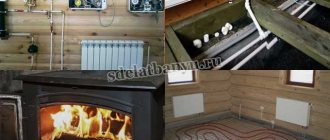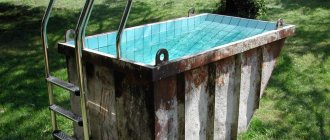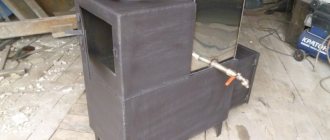In winter, due to a sharp decrease in air temperature and freezing of the soil, ice plugs may form in the external branches of the water supply system. To prevent this from happening, it is necessary to organize heating of the water supply using one or more effective technologies.
The article we presented describes all the methods to prevent the formation of ice in water supply pipes. We will tell you how to properly maintain the functionality of communications in cold weather and prevent equipment breakdown. Do-it-yourselfers will find instructions on how to install thermal insulation and heating systems.
Types of thermal insulation materials
Polyurethane foam shells (PPU)
They are half-cylinders 1 meter long and have different thicknesses and diameters. The structure of this material is closed, fine-celled, thanks to which it practically does not absorb moisture.
Insulating pipes with polyurethane foam eliminates the so-called soaring effect in winter, when the snow cover begins to melt from the heat. Installation of such insulation can be carried out in any season of the year and in any weather, due to the fact that PU foam shells are lightweight.
- ease of installation and dismantling;
- the ability to use this material repeatedly;
- does not cause corrosion;
- ease of access to pipeline sections for repair work;
- long service life.
Installation of polyurethane foam shells is carried out using ties or twists. They can be made with different wall thicknesses, and can also be coated with waterproofing (polyethylene film, moisture-resistant paper, foil) or without it.
Polyurethane foam shells
Fiberglass (glass wool)
This type of pipe insulation is produced by many manufacturers and is a very common material. As a rule, it is used to insulate metal-plastic pipes. The main advantage is the low density of this material.
But there is a significant drawback, which is additional insulation, for example, roofing felt or glass fabric. It follows that such insulation of the water supply will bring extra costs and will take more time during installation.
Fiberglass for thermal insulation of cold water pipes
Expanded polystyrene (foam)
This material is probably the most common in independent use of pipe insulation. You can use foam shells with an outer covering or separately; for them, laying trays is not a necessary circumstance, which is a plus.
Just like the fact that this type of thermal insulation is designed for repeated use. The performance qualities of expanded polystyrene imply its use indoors and outdoors.
Expanded polystyrene is a popular thermal insulation for pipelines
Basalt insulation
In other words, this is basalt fiber, it is presented in the form of cylinders. This insulation is preferable only because it does not require laying trays, which means it is easy to install. True, its cost is somewhat unaffordable, and a considerable amount of money will be required to carry out thermal insulation with this material.
Film heating of pipes
Another way to heat the water main is a film system. Its fundamental difference from cable is only in the main structural element, which is a special film. The pipe is wrapped with this film, and thermal insulation and waterproofing are mounted on top of it.
This method has many advantages, and first of all, uniform heat transfer stands out among them. In addition, film heating has a very simple design and can be installed without problems even by inexperienced installers - all you need to do is secure the film wrapped around the pipe with adhesive tape. The system itself is inexpensive, and its simplicity allows additional savings on installation.
Installation of heating cable
To reliably insulate an outdoor water pipe, you need not only to protect it from the cold, but also to provide heating along its entire length. This can only be done using a special cable.
A system in which the wire is embedded inside the pipe is more effective than the external version. But it is difficult to install and its installation requires special skills. And you can fix the heating cable from the outside yourself.
You need to start laying from the section of the pipeline running inside the house. This way it will warm up the vulnerable spots at the exit from the wall. And it’s easier to connect it to the mains.
- The surface of the pipe is cleaned of dirt and all burrs are removed from it.
- Adhesive aluminum tape is applied in places where the cable is laid. For a longitudinal arrangement - in a strip along the pipe, for a screw arrangement - in a spiral.
- The cable itself is placed on the tape. When winding, the pitch of turns depends on the power of the system. For 20 W, it is enough to wind every 15 - 20 cm. Less powerful devices require a reduction in pitch.
- The laid wire is secured with tape along its entire length.
- A thermal insulation layer is applied on top of the system.
If there are taps or other fittings on the pipeline to be insulated, then they also need to be secured with a cable. Coils must be applied more often than through a pipe.
If the purchased cable does not have a ready-made plug for connection to the network, then you need to carefully splice it with the electrical wire.
To power the heating system, it is better to provide a separate line with a residual current device.
Series "GNSH 380"
Main characteristics: — maximum operating temperature 380°C; — hose made of PFTE tube with corrugated stainless steel braid; — built-in thermocouple; — mineral thermal insulation; — external protection: steel winding; — power cable 1500 mm long; — operating voltage 230 V; — minimum bending radius 500 mm.
| Marking | Specific power, W/m | Power, W | Length, mm | Internal diameter, mm | Working pressure, bar |
| GNSH 6-1/380 | 160 | 160 | 1 | 6 | 125 |
| GNSH 6-2/380 | 160 | 320 | 2 | 6 | 125 |
| GNSH 6-3/380 | 160 | 480 | 3 | 6 | 125 |
| GNSH 6-4/380 | 160 | 640 | 4 | 6 | 125 |
| GNSH 6-5/380 | 160 | 800 | 5 | 6 | 125 |
Description
The basis of all heating hoses is a durable flexible tube through which liquid or gas flows. As a rule, a special high-quality PTFE tube is used, which is resistant to almost all liquids and gases. In addition, it can be used in conditions of temperature changes in the range of -70°C...+260°C. However, hoses can be manufactured in combination with other materials depending on operating conditions and customer requirements. The presence or absence of pressure must be taken into account. In high-temperature and high-pressure environments, single- or double-layer stainless steel braiding is used to reinforce the inside of the hose sheath. Scope of application: Flexible heating hoses are used in cases where it is impossible or impractical to use standard pipelines (most often from one part of the unit to another), and it is necessary to maintain the temperature of the product at the required value, despite fluctuations in ambient temperature and temperature changes inside the installation. They are widely used in the following devices: — installations for the production of foam materials; — wax production equipment; — sprayers; — tools for applying glue (including cold curing); — marking machines; — lines with petroleum products: — gas analysis instruments; — equipment for the food industry.
Sequence of work
At sub-zero temperatures outside, the casing, which protrudes slightly above the floor level, is the first to be negatively affected. The easiest way to insulate is to wrap the surface using metal or plastic mesh. Leaves or sawdust or waterproofing material are poured into the gap provided in advance. Water can have an extremely negative impact on the entire structure, so the floor and external parts of the well structure are additionally finished with roofing felt.
Please note that, in addition to everything, an insulating cover is additionally manufactured and installed, exactly matching the outer diameter of the casing pipe.
Insulation of difficult areas
It is especially important to well insulate from the cold those sections of the pipeline that go to the surface of the earth or pass through the foundation into the house.
One of the most common methods of insulating such an input is as follows:
- A piece of large diameter pipe is inserted into the hole in the foundation. This can be a sewer pipe with a diameter of 100 mm made of PVC;
- A water pipe is inserted into it, centered and secured in this position with tape;
- The space between the pipes is blown out with polyurethane foam from a can;
Insulation insulation diagram
- The space between the outer pipe and the foundation walls is filled with expanded clay, and moisture-resistant insulation is laid over the pipe.
Laying pipes below freezing depth
This method is advisable to use if in winter the soil freezes no deeper than 170 cm. A trench is dug from a well or borehole, the bottom of which is 10-20 cm below this value. Sand (10-15 cm) is added to the bottom; the pipes are laid in a protective casing (corrugated sleeve), then covered with earth.
To avoid having to insulate the outdoor water supply in cold weather, it is better to do this in advance
This is the easiest way to make winter water supply at the dacha, but it is not the best, although it is the cheapest. Its main drawback is that if repairs are necessary, you will have to dig again, and to the full depth. And since it is difficult to determine the location of a leak with this method of laying a water pipeline, there will be a lot of work.
To ensure that there are as few repairs as possible, there should be as few pipe connections as possible. Ideally, there should be none at all. If the distance from the water source to the dacha is greater, make connections carefully, achieving perfect tightness. It is the joints that leak most often.
Choosing a material for pipes in this case is not the easiest task. On one side, a solid mass presses from above, so a strong material is needed, and this is steel. But steel laid in the ground will actively corrode, especially if the groundwater is high. The problem can be solved by properly priming and painting the entire surface of the pipes. Moreover, it is advisable to use thick-walled ones - they will last longer.
The second option is polymer or metal-polymer pipes. They are not subject to corrosion, but they need to be protected from pressure - placed in a protective corrugated sleeve.
One more thing. The depth of soil freezing in the region is determined over the past 10 years - its average indicators are calculated. But firstly, very cold winters with little snow occur periodically, and the ground freezes deeper. Secondly, this value is the average for the region and does not take into account the conditions of the site. Perhaps it is on your piece that freezing may be greater. All this means that when laying pipes, it is still better to insulate them, lay sheets of polystyrene foam or expanded polystyrene on top, as in the photo on the right, or lay them in thermal insulation, as on the left.
You might be interested in reading “How to make automatic watering“.
GNSh “100” series
Main characteristics: — maximum operating temperature 100°C; — hose made of PFTE tube with stainless steel braid; — built-in thermocouple; — thermal insulation: polyurethane foam; — external protection: nylon insulation; — power cable 1500 mm long; — operating voltage 230 V; — minimum bending radius 200 mm.
| Marking | Specific power, W/m | Power, W | Length, mm | Internal diameter, mm | Working pressure, bar |
| GNSH 6-1/100 | 110 | 110 | 1 | 6 | 240 |
| GNSH 6-2/100 | 110 | 220 | 2 | 6 | 240 |
| GNSH 6-3/100 | 110 | 330 | 3 | 6 | 240 |
| GNSH 6-4/100 | 110 | 440 | 4 | 6 | 240 |
| GNSH 6-5/100 | 110 | 550 | 5 | 6 | 240 |
| GNSH 8-1/100 | 130 | 130 | 1 | 8 | 200 |
| GNSH 8-2/100 | 130 | 260 | 2 | 8 | 200 |
| GNSH 8-3/100 | 130 | 390 | 3 | 8 | 200 |
| GNSH 8-4/100 | 130 | 520 | 4 | 8 | 200 |
| GNSH 8-5/100 | 130 | 650 | 5 | 8 | 200 |
| GNSH 10-1/100 | 150 | 150 | 1 | 10 | 175 |
| GNSH 10-2/100 | 150 | 300 | 2 | 10 | 175 |
| GNSH 10-3/100 | 150 | 450 | 3 | 10 | 175 |
| GNSH 10-4/100 | 150 | 600 | 4 | 10 | 175 |
| GNSH 10-5/100 | 150 | 750 | 5 | 10 | 175 |
What is preserving a well for the winter?
When they talk about insulating a well in winter, the topic of “preservation” comes up. This is an alternative option for a well for the winter.
Conservation is the process of closing a well. That is, the well must be covered. To implement it, you need to adhere to a certain plan and then conservation will be successful.
Conservation occurs as follows:
- Preparation: take out the pumping station, water column, disconnect the pipe and hose;
- Carry out chlorination of the well;
- We cover the well with a sealed cap - cap;
- We secure the head with bolts.
To keep your well clean, chlorinate.
Chlorination should be carried out at the rate of a matchbox of bleach per bucket of water. A bucket of water, in turn, is poured per bucket per meter of well. Bleach will help burn out all the organic matter. This can be natural debris, various kinds of bacteria and insects.
This way you will preserve the well for the winter. This will help it stay clean in the winter; debris and insects will not get into it from the ground from a draft, which can even come from inside the well. Carry out canning, and then your well will be clean by the beginning of the spring season of your country house.
How to insulate a cold water pipe
Let's look at how you can insulate a cold water pipe with your own hands. Work begins with taking measurements and selecting insulation. The length of the pipe and its diameter are measured. If you plan to use roll insulation, such as mineral wool, there is no need to measure the diameter of the pipeline, since this is not important. In the case of tubular insulation, the length and diameter of the pipeline are important.
In order to properly insulate a pipe, you must follow several recommendations from craftsmen and manufacturers of thermal insulation materials:
- There should be no uninsulated areas.
- Along the entire length of the pipeline, the insulation must be securely fixed.
- The joints of thermal insulation with foil coating must be taped with metal tape.
- If the system has taps, they must be completely closed with thermal insulation material.
It is convenient to cut the insulation with a regular paper knife. Tape or plastic ties are suitable for fixing. Some manufacturers, complete with insulation, supply fasteners designed to secure it; as a rule, these are plastic clips. The installation step of the fastening clips should not exceed 15 cm.
Clips for pipe insulation
If for reliable insulation it is necessary to make a frame (box), it can be made from boards. The wooden structure is rigid and does not require additional protection from mechanical damage. You can also make a box from foam plastic; it is less durable, but additionally protects the pipeline from freezing. To fasten sheets of foam plastic to each other, it is convenient to use polyurethane foam; in addition, it will save the structure from the penetration of cold, because will fill the gaps between frame elements.
Is it necessary to insulate a well for the winter?
If your autonomous source of water supply is not located directly indoors, but is located outside, then thermal insulation is required. It definitely won’t freeze inside, but outdoors frost can catch it even in the southern regions.
If the upper casing pipe goes into the uninsulated head of the caisson, and a pipeline is led out of it into the house, then the water supply units need thermal insulation. During the cold season, the water will freeze, and this will lead to additional expansion, which may cause the pipeline to explode. Without insulation, a surface-type pump will inevitably be damaged, since the liquid is constantly inside it. The same applies to a submersible pump. Perhaps he himself will not be harmed, but the pipeline coming out of him may also rupture due to the expansion of water when freezing.
Advice from professionals
It happens that the plot was purchased before the onset of winter. The owner had not yet settled in, and the well on the street was already frozen. Professionals advise to soberly assess the situation:
- When a thin crust forms on the surface of the water, it is simply broken with a long rod or a weight tied to a rope.
- When the pipeline is “caught” by frost and the water surface in the well is not frozen, hot water is used for thawing. You can also warm up the pipe with a hairdryer or fan heater.
Freezing of water in winter already signals the need to insulate the water supply source outside.
When water has frozen inside the casing, pump, automation, supply pipeline, it is pointless to reanimate the system in winter. We will have to wait for the end of frost and natural thawing, after which we will carefully work on thermal insulation.
Series "GNSH 200"
Main characteristics: — maximum operating temperature 200°C; — hose made of PFTE tube with stainless steel braid; — built-in thermocouple; — thermal insulation: silicone foam; — external protection: nylon insulation; — power cable 1500 mm long; — operating voltage 230 V; — minimum bending radius 200 mm.
| Marking | Specific power, W/m | Power, W | Length, mm | Internal diameter, mm | Working pressure, bar |
| GNSH 4-1/200 | 90 | 90 | 1 | 4 | 275 |
| GNSH 4-2/200 | 90 | 180 | 2 | 4 | 275 |
| GNSH 4-3/200 | 90 | 270 | 3 | 4 | 275 |
| GNSH 4-4/200 | 90 | 360 | 4 | 4 | 275 |
| GNSH 4-5/200 | 90 | 450 | 5 | 4 | 275 |
| GNSH 6-1/200 | 110 | 110 | 1 | 6 | 240 |
| GNSH 6-2/200 | 110 | 220 | 2 | 6 | 240 |
| GNSH 6-3/200 | 110 | 330 | 3 | 6 | 240 |
| GNSH 6-4/200 | 110 | 440 | 4 | 6 | 240 |
| GNSH 6-5/200 | 110 | 550 | 5 | 6 | 240 |
| GNSH 8-1/200 | 130 | 130 | 1 | 8 | 200 |
| GNSH 8-2/200 | 130 | 260 | 2 | 8 | 200 |
| GNSH 8-3/200 | 130 | 390 | 3 | 8 | 200 |
| GNSH 8-4/200 | 130 | 520 | 4 | 8 | 200 |
| GNSH 8-5/200 | 130 | 650 | 5 | 8 | 200 |
We insulate the inlet water pipe
In addition to the mine itself, the pipeline entering the well and the house also needs thermal insulation. As a rule, in a dacha, the main line leading from the source to the house is laid shallow. This is due to the technically narrow capabilities of the work. That is why it has to be additionally insulated.
Method one into another
Take a plastic or metal pipe with a diameter larger than a water pipe. We will lay it on the base in a trench and lead it to the well, house and equipment. In fact, it will act as a sleeve or case.
There is no need to put it into the mine shaft, 10 centimeters inside is enough, that’s what we will isolate. To facilitate the process, 20–25 centimeters of sawdust are first poured into the trench, on which the pipe is laid. Soft insulation, glass wool, or penoflex is thrown on top. The structure can be covered with soil. We insert a water pipe into the case, leading it into the house and the well.
The air cushion between the insulated sleeve and the water pipe will create an additional barrier to the cold.
Important: for additional waterproofing, the case with insulation is wrapped with roofing felt or polyethylene.
Thermal insulation using penoflex
Modern material, flexible and durable. It looks like cylinders from 3 to 6 meters long. They vary in thickness and density. There is a penoflex for each pipe diameter. In this case, there is no need to use a sleeve. The pipe is completely insulated before installation, gluing all joints with metallized tape. Insulation of highways underground using Penoflex technology is possible at a depth of 70 centimeters.











